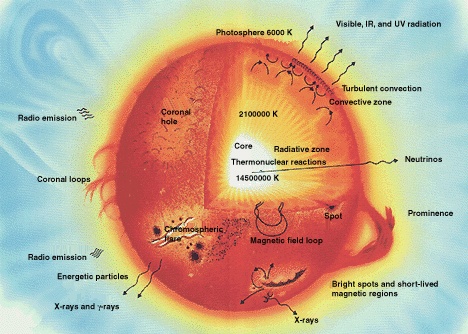
Caption: A diagram of a solar type star or G2 V star.
Features:
- Stars have no sharply defined
surface.
There is just a gradual transition from dense opaque regions to relatively transparent outer region that extents into a stellar wind in all cases it seems???.
- The star
layer from which radially-traveling photons escape to
infinity about half the time (i.e., with probability ∼ 1/2) is called
the photosphere.
One standard formal definition of the photosphere is it is the layer from which the probability of escape to infinity for a radially-traveling photon is almost exp(-2/3) = 0.5134 ... .
- We can call the photosphere the
stellar photosphere
when we want to be explicit.
- Since the photosphere
is the most observable layer of a star,
it is what is conventionally called the surface of
star.
- The photosphere
of most stars radiates approximately
a blackbody spectrum.
- An exact blackbody spectrum
is specified entirely by the temperature
of the radiating surface.
- Photospheres are NOT exactly
blackbody radiators
and have a range of temperatures.
Nevertheless, one can define an average temperature for the photosphere and this average temperature is what is usually called the star's surface temperature or just the star's temperature if you know what you mean.
- The commonest average temperature
to use for the
photospheric temperature
is the
effective temperature.
This temperature assigned to a spherical body of radius equal to the radius of a star's photosphere (defined in some conventional way) would produce exactly the luminosity of that star.
- Actually, the
photospheric temperature
(defined as the
effective temperature) is
close to any other reasonable
average temperature
for the photosphere, and so it
is a good characterizing temperature
for the photosphere.
- The emission from the photosphere
determines the color indices
of a star.
The most important color index is B-V which is apparent B magnitude minus apparent V magnitude.
B-V increases as photospheric temperature decreases.
- A fit of a blackbody spectrum
to a star's
B-V yields an alternative
characteristic average temperature
for the photospheric temperature.
This is kind of photospheric temperature is called a color temperature since a fit to the shape of the star's spectrum (i.e., to the star's mixture of colors loosely speaking).
The peak wavelength of a star's spectrum can be used in Wien's law to obtain another kind of color temperature.
The first kind of color temperature is easier to obtain since you only need photometry which is much easier to measure accurately than spectroscopy.
- Above the photosphere
is the stellar atmosphere.
- For most stars,
the stellar atmosphere
produces an absorption line spectrum
superimposed on the
approximate blackbody spectrum
of the photosphere.
- The
absorption line spectrum
of a star
determines its
OBAFGKM spectral type.
- Actually photospheric temperature, B-V, and spectra type are tightly correlated and can be used as alternative parameters in a Hertzsprung-Russell (HR) diagram.
Credit/Permission:
Project leader: Dr. Jim Lochner; Curator: Meredith Gibb; Responsible NASA Official:Phil Newman,
2006 /
Public domain.
Image link: Wikipedia.
Local file: local link: star_g2_v.html.
File: Star file:
star_g2_v.html.